The Poon Hill – Ghandruk Village Trek in Nepal’s Annapurna region offers an unforgettable adventure for outdoor enthusiasts. Over the course of four days, trekkers will be captivated by the stunning vistas of the Dhaulagiri and Annapurna mountain ranges, while seeing the rich cultural fabric of rural Himalayan villages. From comfortable guesthouse accommodations to guided tours that introduce local communities, this moderately challenging trek promises an exhilarating blend of natural beauty and cultural exploration. With the opportunity to witness the resilience of the Himalayan landscape firsthand, this journey is sure to leave a lasting impression.
This experience made our list of the 20 Best 4 Day Tours In Pokhara.
Key Points
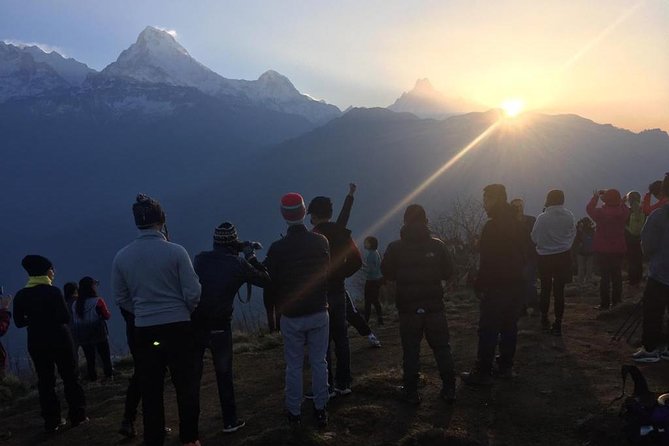
- This 4-day trek in the Pokhara region offers close-up views of the Dhaulagiri and Annapurna mountain ranges, providing a scenic and culturally immersive experience.
- The trek is moderately challenging, with uphill and downhill sections that require good fitness and endurance from participants.
- The tour includes private transportation, accommodation in guesthouses, and coverage for emergency rescue costs, ensuring a stress-free trekking experience.
- Visitors can explore rural mountain villages, interact with friendly locals, and learn about their agricultural practices and customs.
- The trek is not recommended for those with serious medical conditions or mobility issues, as the high-altitude environment and rugged terrain can be physically demanding.
Trek Overview
The Poon Hill – Ghandruk Village trek is a 4-day adventure that takes travelers on a moderately challenging journey through the stunning landscapes of Nepal’s Pokhara region.
Located in the heart of the Annapurna mountain range, this trek offers close-up views of some of Nepal’s tallest peaks, including the iconic Dhaulagiri and Annapurna ranges.
Along the way, trekkers will visit rural mountain villages, seeing the local culture and way of life.
The trek is suitable for most travelers, though it’s not recommended for those with back problems, pregnant women, or those with serious medical conditions.
With its breathtaking scenery and cultural experiences, the Poon Hill – Ghandruk Village trek is a must-do for anyone visiting the Pokhara region.
Ready to hit more trails? More hiking adventures we feature in Pokhara
Included in the Tour
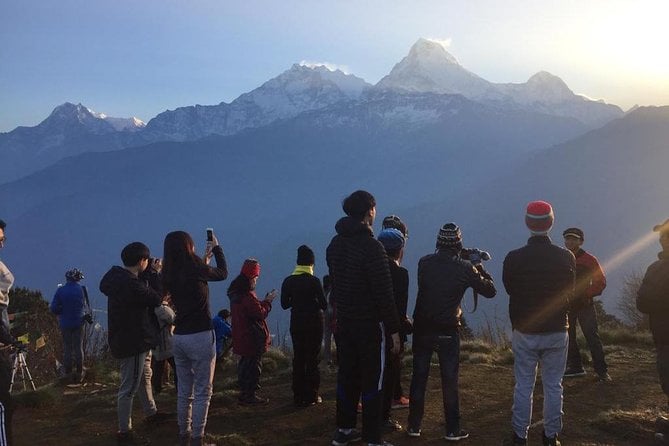
This 4-day Poon Hill – Ghandruk Village trek package includes a variety of services to ensure a comfortable and seamless experience for travelers.
The tour is led by a private, English-speaking trekking guide who’ll share their local knowledge and expertise throughout the journey.
Accommodation is provided in guesthouses along the way, and a permit for the Annapurna Conservation Area as well as a TIMS card are included.
Travelers will be picked up and dropped off at their hotel within the Lakeside area of Pokhara, and round-trip transportation by private vehicle is provided.
All meals can be purchased during the trek, and emergency rescue costs are covered in case of any issues. Optional gratuity is also available.
Pickup Information
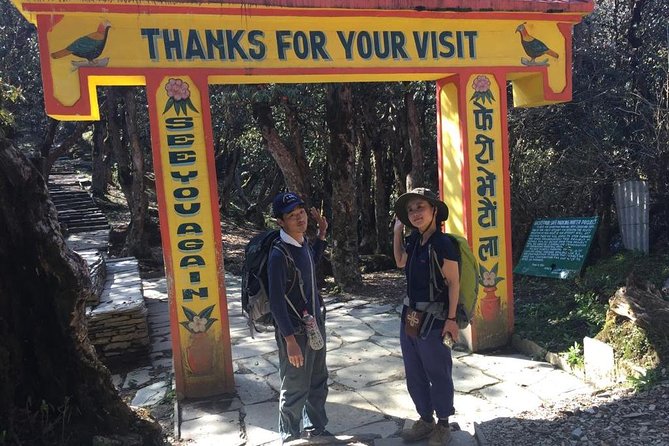
Travelers are picked up from selected points within the Lakeside area of Pokhara, with the start time being 08:15 AM. The pickup service is included in the tour, ensuring a seamless start to the trekking adventure.
Guests don’t have to worry about navigating to the departure point, as the private vehicle will come to their hotel or guesthouse within the Lakeside area. This convenient pickup arrangement allows everyone to begin the trek together at the scheduled time, maximizing the time spent on the trails and in the stunning mountain villages.
The tour operator’s attention to these logistical details contributes to an overall stress-free and enjoyable trekking experience for participants.
Health and Accessibility
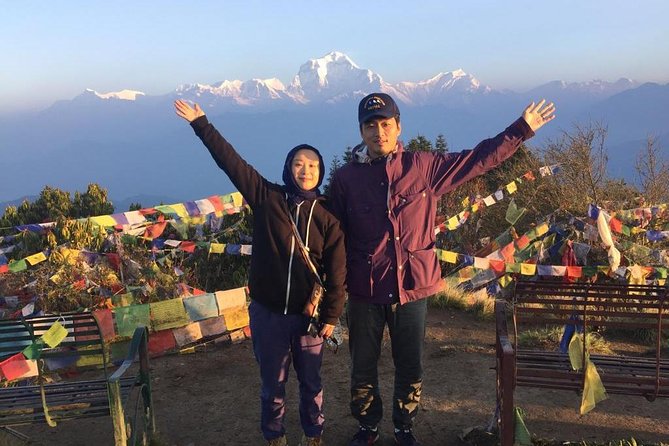
Moving on to the health and accessibility considerations, the trek isn’t wheelchair accessible and isn’t recommended for travelers with back problems, pregnant women, or those with serious medical conditions. However, most travelers can still participate in this moderately challenging hike.
Some key points to consider include:
-
The trek involves several uphill and downhill sections, which may be difficult for those with mobility issues.
-
The high-altitude environment can be taxing, especially for those unaccustomed to it.
-
Trekking at high altitudes can exacerbate certain medical conditions, such as heart or respiratory issues.
-
Pregnant women may face increased risks due to the physical demands of the trek.
-
Travelers with any pre-existing conditions should consult with a healthcare professional before booking the trek.
Pricing and Reviews
The Poon Hill – Ghandruk Village trek is priced from $339.34 per person, with the exact cost varying based on group size.
Travelers can take advantage of the free cancellation policy up to 24 hours before the start of the experience, and the company offers a lowest price guarantee.
The trek has received excellent reviews, earning a 5.0 rating across 11 reviews on platforms like Viator and Tripadvisor.
The positive feedback highlights the trek’s key features, including the stunning close-up views of Nepal’s towering mountains, the opportunity to explore rural mountain villages, and the knowledgeable English-speaking guide.
With the inclusive package covering permits, transportation, accommodations, and meals, the Poon Hill – Ghandruk Village trek offers an exceptional value for the price.
Here are more great tours and experiences we've reviewed in Pokhara
Scenic Views of Mountains
Towering over the trekkers, Nepal’s highest peaks, including the iconic Annapurna and Dhaulagiri ranges, come into breathtaking view during the Poon Hill – Ghandruk Village trek.
The highlight of the trek is the ascent to Poon Hill, which offers unparalleled panoramic vistas of the surrounding mountains.
Trekkers will be awestruck by the following:
-
Majestic Dhaulagiri (8,167m), the 7th highest mountain in the world
-
Towering Annapurna I (8,091m), the 10th highest peak on Earth
-
Fishtail-shaped Machhapuchhre, a sacred mountain that’s off-limits to climbers
-
Stunning sunrise and sunset views that paint the peaks in ever-changing hues
-
Incredible close-up looks at the ice-capped summits and rugged glaciers
Exploration of Rural Villages
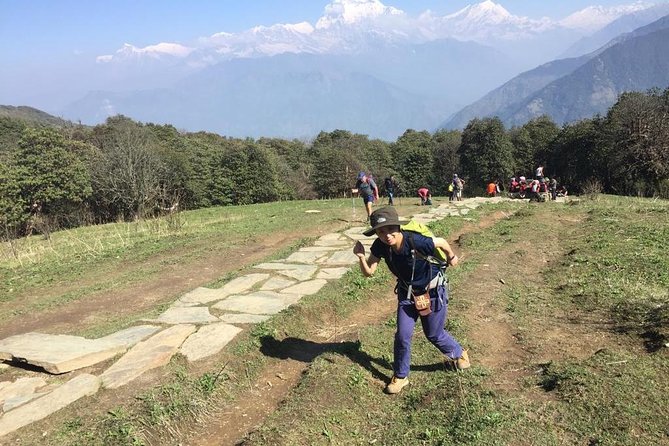
Along the Poon Hill – Ghandruk Village trek, trekkers enjoy the vibrant culture and traditional way of life of Nepal’s rural mountain communities. They’ll have opportunities to wander through quaint villages, interact with friendly locals, and gain insight into the region’s agricultural practices and time-honored customs.
From the charming stone houses and terraced farmlands of Ghandruk to the bustling trails connecting remote hamlets, the trek offers a genuine window into the daily rhythms of Himalayan village life. Visitors can observe farmers tending their crops, witness artisans practicing centuries-old crafts, and explore the intricate network of trails that link these resilient mountain settlements.
This immersive experience provides a profound appreciation for the resilience and self-sufficiency of Nepal’s rural populations.
Trekking Experience and Difficulty
Pokhara: 4 Days Poon Hill – Ghandruk Village Trek
Trekking Experience and Difficulty
While the rural villages offer a fascinating cultural experience, the Poon Hill – Ghandruk Village trek itself presents a moderately challenging physical journey for trekkers.
The trail winds through diverse terrain, including steady ascents, steep descents, and rugged mountain paths, requiring a good level of fitness and endurance from participants.
Trekkers can expect to encounter:
-
Steep uphill sections that test leg strength
-
Uneven, rocky paths that demand agility
-
High altitudes that can cause altitude sickness
-
Varying weather conditions, from sun to rain and cold
-
Long daily trekking times, up to 6-7 hours
Frequently Asked Questions
Can I Bring My Own Food and Snacks?
Trekkers are generally allowed to bring their own food and snacks on treks, though the tour operator typically provides meals during the trek. Hikers should check with the tour company about any restrictions or meal plans included in the package.
Are There Any Special Permits Required for the Trek?
The trek requires a conservation area permit and a TIMS (Trekkers’ Information Management System) card, which the tour operator typically arranges as part of the package. These permits are necessary to access and trek within the designated protected areas.
What Should I Pack for This Trek?
When packing for a moderately challenging trek, one should bring proper hiking boots, warm layers, rain gear, sun protection, snacks, water, a headlamp, and any necessary personal items. Research the climate and terrain to ensure you have the right gear for the experience.
Can I Extend or Shorten the Trek Duration?
The trek duration can be extended or shortened, but it’s best to discuss options with the tour provider. They can advise on the feasibility and implications of modifying the itinerary to meet the traveler’s needs and preferences.
Is Travel Insurance Mandatory for This Trek?
Travel insurance is not typically mandatory for treks, but it’s highly recommended. It can cover unexpected medical expenses, trip cancellations, and emergency evacuations, providing valuable protection. Travelers should consult with the tour operator to understand any specific requirements or recommendations.
Recap
The Pokhara: 4 Days Poon Hill – Ghandruk Village Trek offers an immersive cultural and natural experience in the stunning Annapurna region.
Trekkers can expect breathtaking mountain vistas, comfortable accommodations, and the chance to engage with local communities.
With moderate difficulty, this tour provides an exhilarating adventure for those seeking to explore the Himalayan landscape and gain insight into rural Nepali life.
More 4-Day Experiences in Pokhara
More Hiking & Trekking Tours in Pokhara
More Tour Reviews in Pokhara
Not for you? Here's more things to do in Pokhara we have recnetly reviewed
- 2 Best Dining Experiences In Pokhara
- 20 Best 2 Day Tours In Pokhara
- 2 Best Dinner Tours In Pokhara
- 20 Best 3 Day Tours In Pokhara
- 20 Best 4 Day Tours In Pokhara
- 8 Best Cruises And Boat Tours In Pokhara
- 20 Best Full-Day Tours In Pokhara
- 16 Best Helicopter Flights And Tours In Pokhara
- Best 4 Day Tours In Naya Pul
- 7 Best Massage And Relaxation Services In Pokhara
- 6 Best Photography Experiences In Pokhara
- Ghorepani Poonhill Trek
